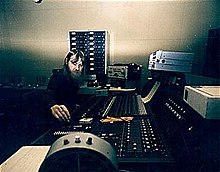Conny Plank
| Conny Plank | |
|---|---|

Conny Plank at the Windrose studio, Hamburg.
|
|
| Background information | |
| Birth name | Konrad Plank |
| Born | May 3, 1940 |
| Origin | Germany |
| Died | December 18, 1987 (aged 47) |
| Genres | Experimental rock, krautrock, new wave, electronic, ambient, progressive rock, techno, electronica |
| Occupation(s) | Producer, musician |
| Instruments | Synthesizer, keyboards, guitar, percussion |
| Years active | 1969–1987 |
| Labels | Sky, Drag City, Curious Music, Brain |
| Associated acts | Can, Cluster, Holger Czukay, DAF, Brian Eno, Eurythmics, Harmonia, Hunters & Collectors, Jane, Kluster, Kraan, Kraftwerk, Guru Guru, Killing Joke, Liliental, Dieter Moebius, Moebius & Plank, Gianna Nannini, Mani Neumeier, Neu!, Night Sun, Organisation, Os Mundi, Play Dead, Hans-Joachim Roedelius, Scorpions, Mayo Thompson, The Tourists, Ultravox, The Meteors |
Konrad "Conny" Plank (May 3, 1940 – December 18, 1987) was a German record producer and musician. He was born in Hütschenhausen. His creativity as a sound engineer and producer helped to shape many innovative recordings of postwar European popular music, covering a wide range of genres including progressive, avant-garde, electronic music and krautrock. His immense catalog of work has greatly influenced modern studio production and engineering techniques.
As a musician, Plank is credited on albums by Guru Guru, Kraan, Cluster, Liliental and Os Mundi. He collaborated with Dieter Moebius on five Moebius & Plank studio albums recorded between 1979 and 1986. The Moebius & Plank sound foreshadowed techno and electronica and influenced many later musicians.
Plank and the bands he worked with in Germany had a strong influence on mainstream rock artists, some of whom were able to popularise aspects of his production technique and his highly distinctive sonic approach. In the 1980s the new generation of electronic pop bands were able to realise his ideas in performance as computerised electronic instruments became readily available.
Plank (who began his career as soundman for Marlene Dietrich) was an ardent believer in the possibilities of electronic music and a master of creating startling electronic soundscapes, but he was also adept at blending them with conventional sounds, or natural sounds given unconventional treatments, such as using large metal containers and other industrial objects as percussion instruments.
He was one of the first European producers to fully exploit the possibilities of using multi-track recording facilities to create dramatic production effects and treatments that acted as musical and rhetorical elements in their own right, rather than mere gimmicks. He favoured sometimes harsh-sounding effects and contrasting audio spaces for each element in the mix. His best work stands in stark opposition to the smooth, 'evened-out' sound that predominated in most commercial pop and rock at that time.
...
Wikipedia
